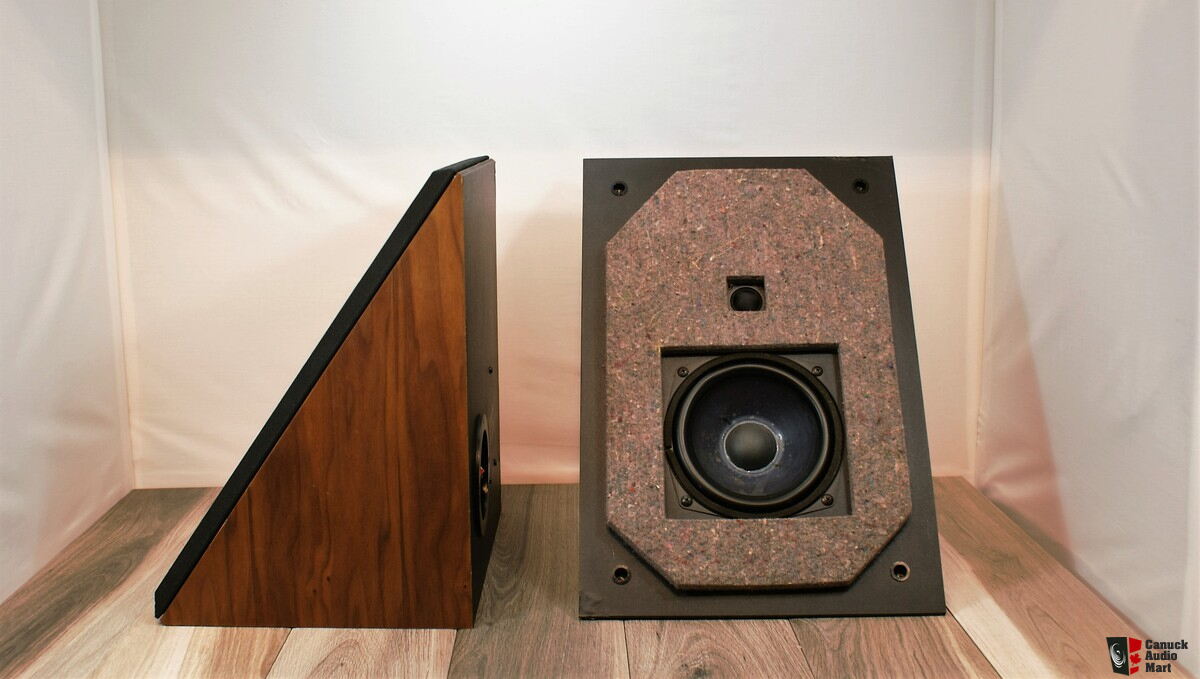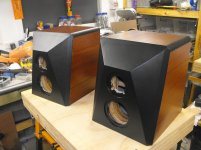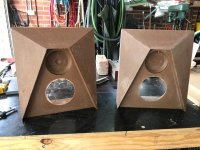The next big benefit that I have found is attention to diffraction in the room nearby the speakers. I always see photos of peoples setup with lots and lots of stuff all around the speakers diffracting away.
Question: So also a diffusor on the front wall between the speakers might rather be mixed blessings?
Yea, I would say that's true or maybe not mixed, perhaps sub-optimal. I try and completely absorb the rear wall reflections (behind the speakers). This seems to improve the imaging quite a bit. Rear wall reflections, coming from an axis close to that of the sound source, will be quite significant psychoacoustically. Best not to have them.
"Diffraction, which occurs at every sharp cabinet boundary, creates delayed, reverse-phase phantom sources that interfere with the direct sound from the actual driver. These secondary phantom images create significant ripples in the midrange response (up to 6 dB) and create delayed sounds which disrupt the timing cues necessary to perceive stereo images. These dispersion problems are audible as room-dependent colorations, coarse midrange, diffuse stereo, and a "detenting" effect that pulls images in towards the loudspeaker cabinets."
The Art of Speaker Design
The Art of Speaker Design
I've measured the effect of heavy felt like that. It was surprising how much like a piece of solid wood it behaves at mid to high frequencies!
I've measured the effect of heavy felt like that. It was surprising how much like a piece of solid wood it behaves at mid to high frequencies!
angle of incidence?
My baffles are based on Olson's baffle shape fig 2L, fig 17 which compare very well to a spherical baffle fig 2A, fig 6 of his AES paper.
http://www.aes.org/aeshc/pdf/how.the.aes.began/olson_direct-radiator-loudspeaker-enclosures.pdf
I now cast the baffle from a resin/bentonite composite which has a superior damping performance compared to wood based materials like mdf or ply.
damping factor values - audio qualia
http://www.aes.org/aeshc/pdf/how.the.aes.began/olson_direct-radiator-loudspeaker-enclosures.pdf
I now cast the baffle from a resin/bentonite composite which has a superior damping performance compared to wood based materials like mdf or ply.
damping factor values - audio qualia
Attachments
angle of incidence?
Pretty much as shown in your photo. Got strong reflections agreeing with distance from driver center to edge of felt. (Need to look at impulse response to see)
Pretty much as shown in your photo. Got strong reflections agreeing with distance from driver center to edge of felt.
and after that? I mean - were there strong reflections agreeing with distance from driver center to edge of the actual baffle?
Not that I remember, the reflection edge seemed to have moved to the edge of the felt (about as you'd expect from a piece of wood there)
I'd think the concept is likely sound, but the density and ability to transmit sound aren't the same in the felt I had as were needed to absorb sound waves all that much (which would be a narrow target to hit in the material science, I imagine). I was surprised, expected it to help a lot, but it really didin't. I suspect something fibrous but less densely packed would be in the right direction.
Yes, perhaps
anyway, in the case of the Spica I think that the slanted baffle is even more important factor
anyway, in the case of the Spica I think that the slanted baffle is even more important factor
Can anyone refer me to scientific studies on the audibility of diffraction?
As far as audibility goes the only study that I know of was Lidia and mine. It was an AES preprint (may be on my website, I don't remember.) It was never presented nor published as a paper because at the same time as the convention, Lidia's mother died and that messed things up a lot.
The simulations were "diffraction like" but more akin to the diffraction effects that one gets in a waveguide, which was my main interest of course. But to me diffraction is going to have the same effect regardless of its cause.
The results have been described here many times so I won't bore people with those again.
How so, what is it slanted in relation to? Free space? It is naiive to assume that any absorption will dissipate diffraction, it can also be the cause of it.I think that the slanted baffle is even more important factor
How so, what is it slanted in relation to?
? in relation to the listening axis of course
It is naiive to assume that any absorption will dissipate diffraction, it can also be the cause of it.
who says "any"?
I don't see how this will alter the quantity of or locations of the diffraction sources as the driver sees them. Are you suggesting only that it will 'mix it up' for the listener?? in relation to the listening axis of course
Last edited:
I don't see how this will alter the quantity of or locations of the diffraction sources as the driver sees them.
it will alter the way the ear "sees" them
Yea, I would say that's true or maybe not mixed, perhaps sub-optimal. I try and completely absorb the rear wall reflections (behind the speakers). This seems to improve the imaging quite a bit. Rear wall reflections, coming from an axis close to that of the sound source, will be quite significant psychoacoustically. Best not to have them.
Which I guess brings you to Joachim Gerhard's study on speaker placement to lessen the more psychoacoustically significant reflections for better soundstage.
Joachim Gerhard speaker placement! WOW and I need more info
side-wall positioning - "Beveridge placement" looks most promising in any given rectangular room

check Yourself using this handy tool: http://www.linkwitzlab.com/LX521/Dipole%20First%20Room%20Reflections%20SL%20rev4-b.xls
from Listening_room
In case of side-wall "Beveridge placement" one has just to treat the wall near the speakers, then this method of speaker placement seems to be the winner.

check Yourself using this handy tool: http://www.linkwitzlab.com/LX521/Dipole%20First%20Room%20Reflections%20SL%20rev4-b.xls
from Listening_room
In case of side-wall "Beveridge placement" one has just to treat the wall near the speakers, then this method of speaker placement seems to be the winner.
- Home
- Loudspeakers
- Multi-Way
- What are some good example of baffle design to improve diffraction


